Migrant Labor in Singapore: Economic and Social Impact Report
VerifiedAdded on 2023/06/05
|8
|1858
|485
Report
AI Summary
This report examines the significant role of migrant labor in Singapore's economy. It delves into the experiences of migrant workers, primarily employed in the construction sector, and the reasons behind their recruitment, including skill shortages and local preferences for white-collar jobs. The report highlights the benefits of migrant labor, such as addressing skill gaps, fostering innovation through cultural exchange, and boosting industrialization and exports. It also addresses concerns about potential displacement of local workers and the impact on wages and working conditions, particularly in sectors like construction and engineering. The report emphasizes the importance of decent work conditions, fair wages, and protection of migrant worker rights, while also discussing the need for agencies to enforce minimum wage standards and address issues like discrimination and exploitation. The conclusion stresses the importance of migrant labor for Singapore's socio-economic development and recommends government actions to protect workers' rights and ensure fair treatment.
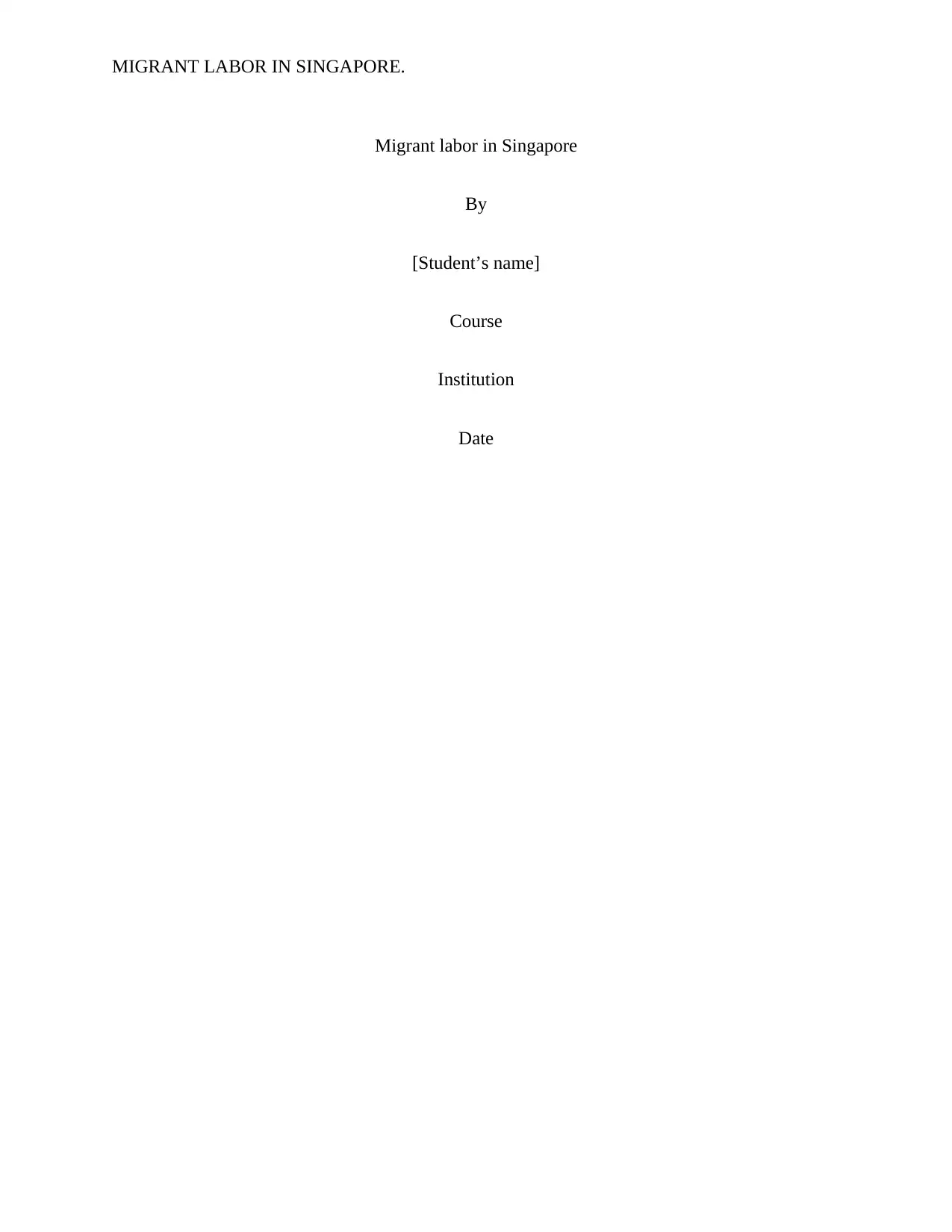
MIGRANT LABOR IN SINGAPORE.
Migrant labor in Singapore
By
[Student’s name]
Course
Institution
Date
Migrant labor in Singapore
By
[Student’s name]
Course
Institution
Date
Paraphrase This Document
Need a fresh take? Get an instant paraphrase of this document with our AI Paraphraser
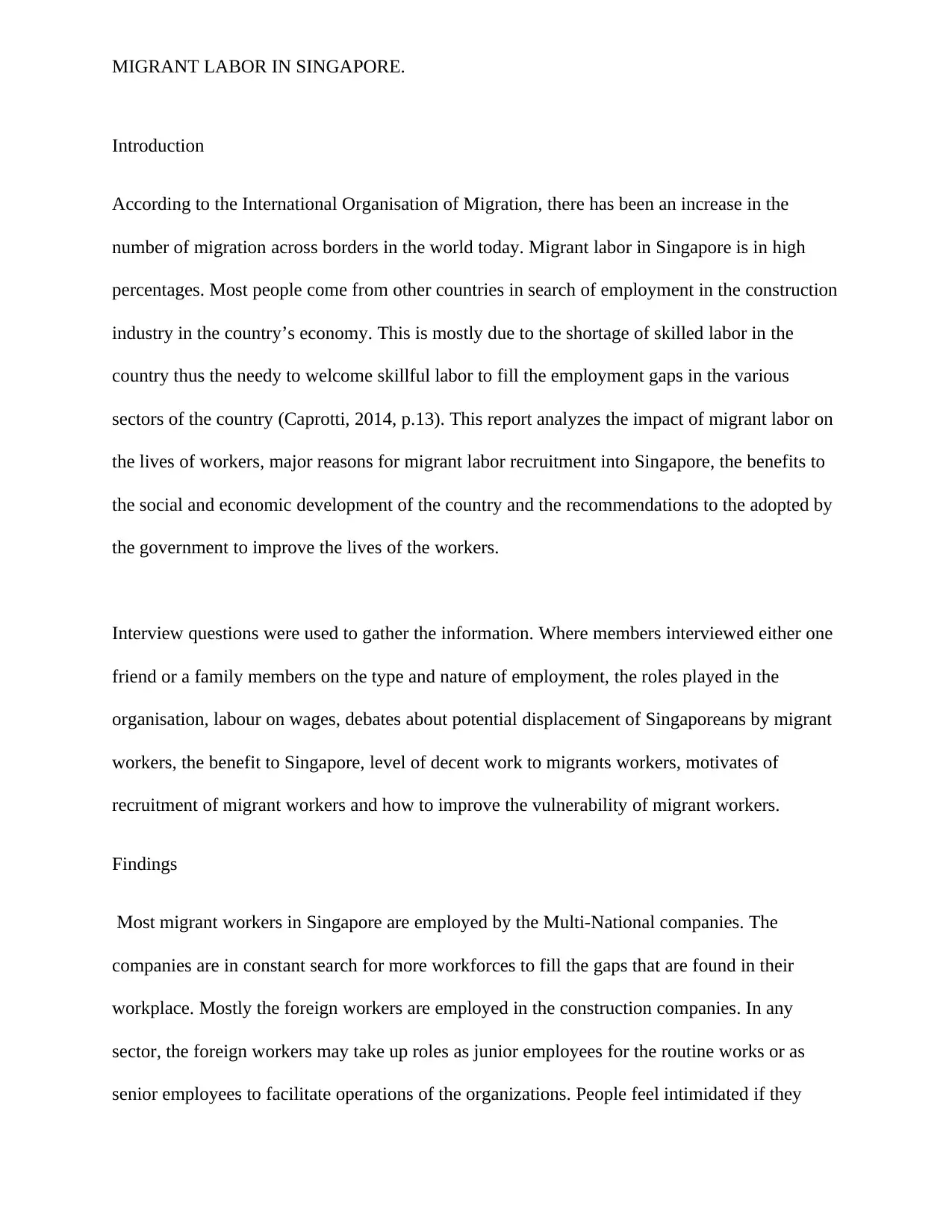
MIGRANT LABOR IN SINGAPORE.
Introduction
According to the International Organisation of Migration, there has been an increase in the
number of migration across borders in the world today. Migrant labor in Singapore is in high
percentages. Most people come from other countries in search of employment in the construction
industry in the country’s economy. This is mostly due to the shortage of skilled labor in the
country thus the needy to welcome skillful labor to fill the employment gaps in the various
sectors of the country (Caprotti, 2014, p.13). This report analyzes the impact of migrant labor on
the lives of workers, major reasons for migrant labor recruitment into Singapore, the benefits to
the social and economic development of the country and the recommendations to the adopted by
the government to improve the lives of the workers.
Interview questions were used to gather the information. Where members interviewed either one
friend or a family members on the type and nature of employment, the roles played in the
organisation, labour on wages, debates about potential displacement of Singaporeans by migrant
workers, the benefit to Singapore, level of decent work to migrants workers, motivates of
recruitment of migrant workers and how to improve the vulnerability of migrant workers.
Findings
Most migrant workers in Singapore are employed by the Multi-National companies. The
companies are in constant search for more workforces to fill the gaps that are found in their
workplace. Mostly the foreign workers are employed in the construction companies. In any
sector, the foreign workers may take up roles as junior employees for the routine works or as
senior employees to facilitate operations of the organizations. People feel intimidated if they
Introduction
According to the International Organisation of Migration, there has been an increase in the
number of migration across borders in the world today. Migrant labor in Singapore is in high
percentages. Most people come from other countries in search of employment in the construction
industry in the country’s economy. This is mostly due to the shortage of skilled labor in the
country thus the needy to welcome skillful labor to fill the employment gaps in the various
sectors of the country (Caprotti, 2014, p.13). This report analyzes the impact of migrant labor on
the lives of workers, major reasons for migrant labor recruitment into Singapore, the benefits to
the social and economic development of the country and the recommendations to the adopted by
the government to improve the lives of the workers.
Interview questions were used to gather the information. Where members interviewed either one
friend or a family members on the type and nature of employment, the roles played in the
organisation, labour on wages, debates about potential displacement of Singaporeans by migrant
workers, the benefit to Singapore, level of decent work to migrants workers, motivates of
recruitment of migrant workers and how to improve the vulnerability of migrant workers.
Findings
Most migrant workers in Singapore are employed by the Multi-National companies. The
companies are in constant search for more workforces to fill the gaps that are found in their
workplace. Mostly the foreign workers are employed in the construction companies. In any
sector, the foreign workers may take up roles as junior employees for the routine works or as
senior employees to facilitate operations of the organizations. People feel intimidated if they

MIGRANT LABOR IN SINGAPORE.
work under foreigners and this may cause chaos which may lead to foreigners being harassed for
occupying top jobs in the host nations (Huang, et al. 2012, p.204). Junior positions in different
organizations attract low pay and residents of Singapore are not willing to take up the roles
because migrant labor has led to reduced wages because labor supply exceeds demand.
The high recruitment of migrant workers is noted to be due to skills shortage where locals
especially fresh graduates do not wish to work for jobs with low pay. Also, most locals make
choices on the type of work they wish to do. For instance, most of the local employees are not
willing to work at the construction sites in the country. This makes these companies look for
employees from other countries to fill the existing gaps (Wise, and Velayutham, 2014, p.417).
Graduates from different universities are always looking for white collar jobs and there is a
perception that educated people should not work in construction sites because that is not their
area of specialization. This notion forces many organizations to make the good use if foreigners
who are willing to perform the roles which are looked upon by Singapore citizens.
It is realized that welcoming foreign employees to Singapore will result in brain gain through
new skills acquisition in the organizations. The interaction of locals and foreign works will bring
about the exchange of ideas at them, as a result, more innovations in the economy (Lorente,
2012, p.201). Skill and labor shortage will be addressed in the country since there will be more
skilled people to add to the available local employees thus increasing organizational
productivity. Singapore developmental goals will be achieved easily due to the availability of
labor and an increase in innovations. Availability of labor will increase industrialization in the
country and this will boost the export sector. Exports in return will help in the balance of trade as
more revenue will be realized.
work under foreigners and this may cause chaos which may lead to foreigners being harassed for
occupying top jobs in the host nations (Huang, et al. 2012, p.204). Junior positions in different
organizations attract low pay and residents of Singapore are not willing to take up the roles
because migrant labor has led to reduced wages because labor supply exceeds demand.
The high recruitment of migrant workers is noted to be due to skills shortage where locals
especially fresh graduates do not wish to work for jobs with low pay. Also, most locals make
choices on the type of work they wish to do. For instance, most of the local employees are not
willing to work at the construction sites in the country. This makes these companies look for
employees from other countries to fill the existing gaps (Wise, and Velayutham, 2014, p.417).
Graduates from different universities are always looking for white collar jobs and there is a
perception that educated people should not work in construction sites because that is not their
area of specialization. This notion forces many organizations to make the good use if foreigners
who are willing to perform the roles which are looked upon by Singapore citizens.
It is realized that welcoming foreign employees to Singapore will result in brain gain through
new skills acquisition in the organizations. The interaction of locals and foreign works will bring
about the exchange of ideas at them, as a result, more innovations in the economy (Lorente,
2012, p.201). Skill and labor shortage will be addressed in the country since there will be more
skilled people to add to the available local employees thus increasing organizational
productivity. Singapore developmental goals will be achieved easily due to the availability of
labor and an increase in innovations. Availability of labor will increase industrialization in the
country and this will boost the export sector. Exports in return will help in the balance of trade as
more revenue will be realized.
⊘ This is a preview!⊘
Do you want full access?
Subscribe today to unlock all pages.

Trusted by 1+ million students worldwide
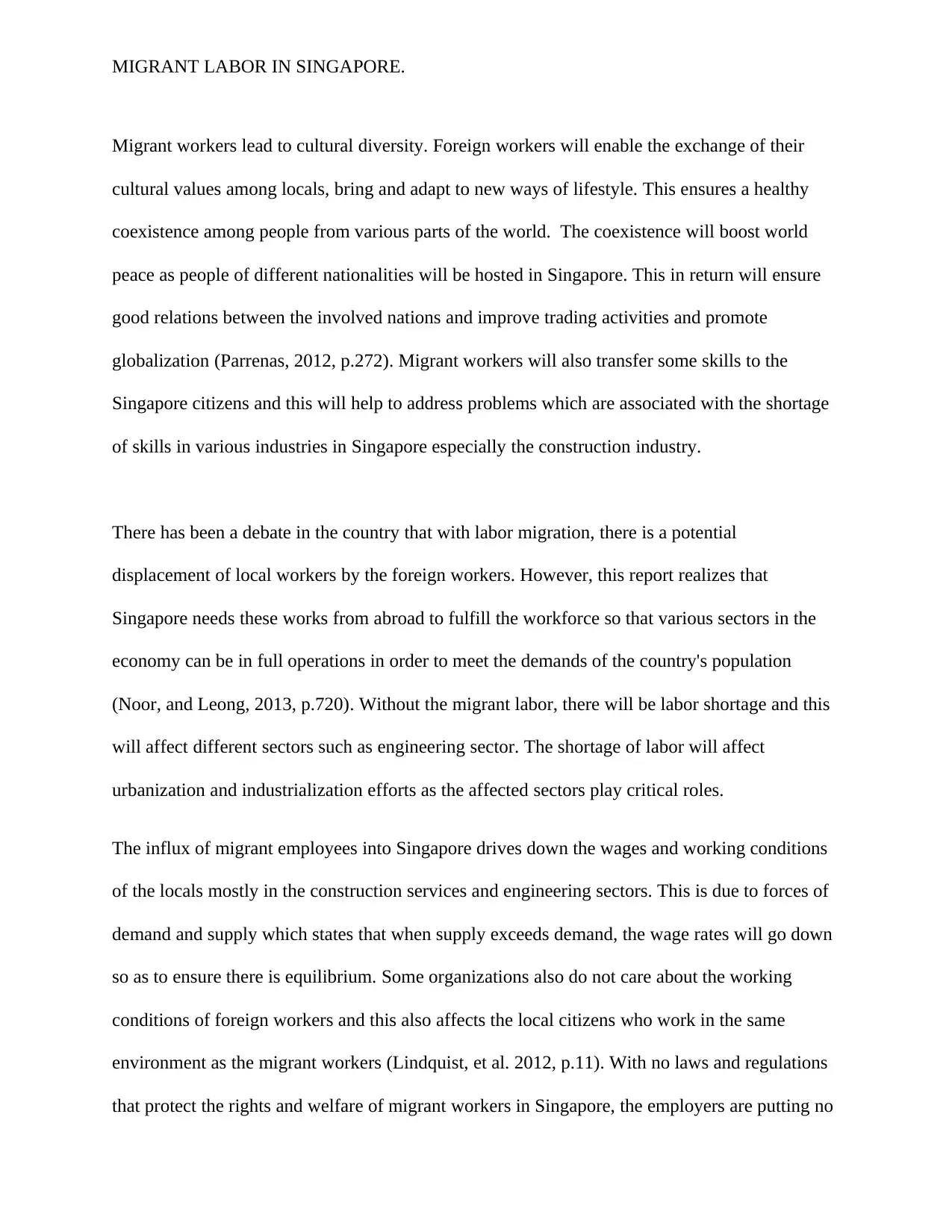
MIGRANT LABOR IN SINGAPORE.
Migrant workers lead to cultural diversity. Foreign workers will enable the exchange of their
cultural values among locals, bring and adapt to new ways of lifestyle. This ensures a healthy
coexistence among people from various parts of the world. The coexistence will boost world
peace as people of different nationalities will be hosted in Singapore. This in return will ensure
good relations between the involved nations and improve trading activities and promote
globalization (Parrenas, 2012, p.272). Migrant workers will also transfer some skills to the
Singapore citizens and this will help to address problems which are associated with the shortage
of skills in various industries in Singapore especially the construction industry.
There has been a debate in the country that with labor migration, there is a potential
displacement of local workers by the foreign workers. However, this report realizes that
Singapore needs these works from abroad to fulfill the workforce so that various sectors in the
economy can be in full operations in order to meet the demands of the country's population
(Noor, and Leong, 2013, p.720). Without the migrant labor, there will be labor shortage and this
will affect different sectors such as engineering sector. The shortage of labor will affect
urbanization and industrialization efforts as the affected sectors play critical roles.
The influx of migrant employees into Singapore drives down the wages and working conditions
of the locals mostly in the construction services and engineering sectors. This is due to forces of
demand and supply which states that when supply exceeds demand, the wage rates will go down
so as to ensure there is equilibrium. Some organizations also do not care about the working
conditions of foreign workers and this also affects the local citizens who work in the same
environment as the migrant workers (Lindquist, et al. 2012, p.11). With no laws and regulations
that protect the rights and welfare of migrant workers in Singapore, the employers are putting no
Migrant workers lead to cultural diversity. Foreign workers will enable the exchange of their
cultural values among locals, bring and adapt to new ways of lifestyle. This ensures a healthy
coexistence among people from various parts of the world. The coexistence will boost world
peace as people of different nationalities will be hosted in Singapore. This in return will ensure
good relations between the involved nations and improve trading activities and promote
globalization (Parrenas, 2012, p.272). Migrant workers will also transfer some skills to the
Singapore citizens and this will help to address problems which are associated with the shortage
of skills in various industries in Singapore especially the construction industry.
There has been a debate in the country that with labor migration, there is a potential
displacement of local workers by the foreign workers. However, this report realizes that
Singapore needs these works from abroad to fulfill the workforce so that various sectors in the
economy can be in full operations in order to meet the demands of the country's population
(Noor, and Leong, 2013, p.720). Without the migrant labor, there will be labor shortage and this
will affect different sectors such as engineering sector. The shortage of labor will affect
urbanization and industrialization efforts as the affected sectors play critical roles.
The influx of migrant employees into Singapore drives down the wages and working conditions
of the locals mostly in the construction services and engineering sectors. This is due to forces of
demand and supply which states that when supply exceeds demand, the wage rates will go down
so as to ensure there is equilibrium. Some organizations also do not care about the working
conditions of foreign workers and this also affects the local citizens who work in the same
environment as the migrant workers (Lindquist, et al. 2012, p.11). With no laws and regulations
that protect the rights and welfare of migrant workers in Singapore, the employers are putting no
Paraphrase This Document
Need a fresh take? Get an instant paraphrase of this document with our AI Paraphraser
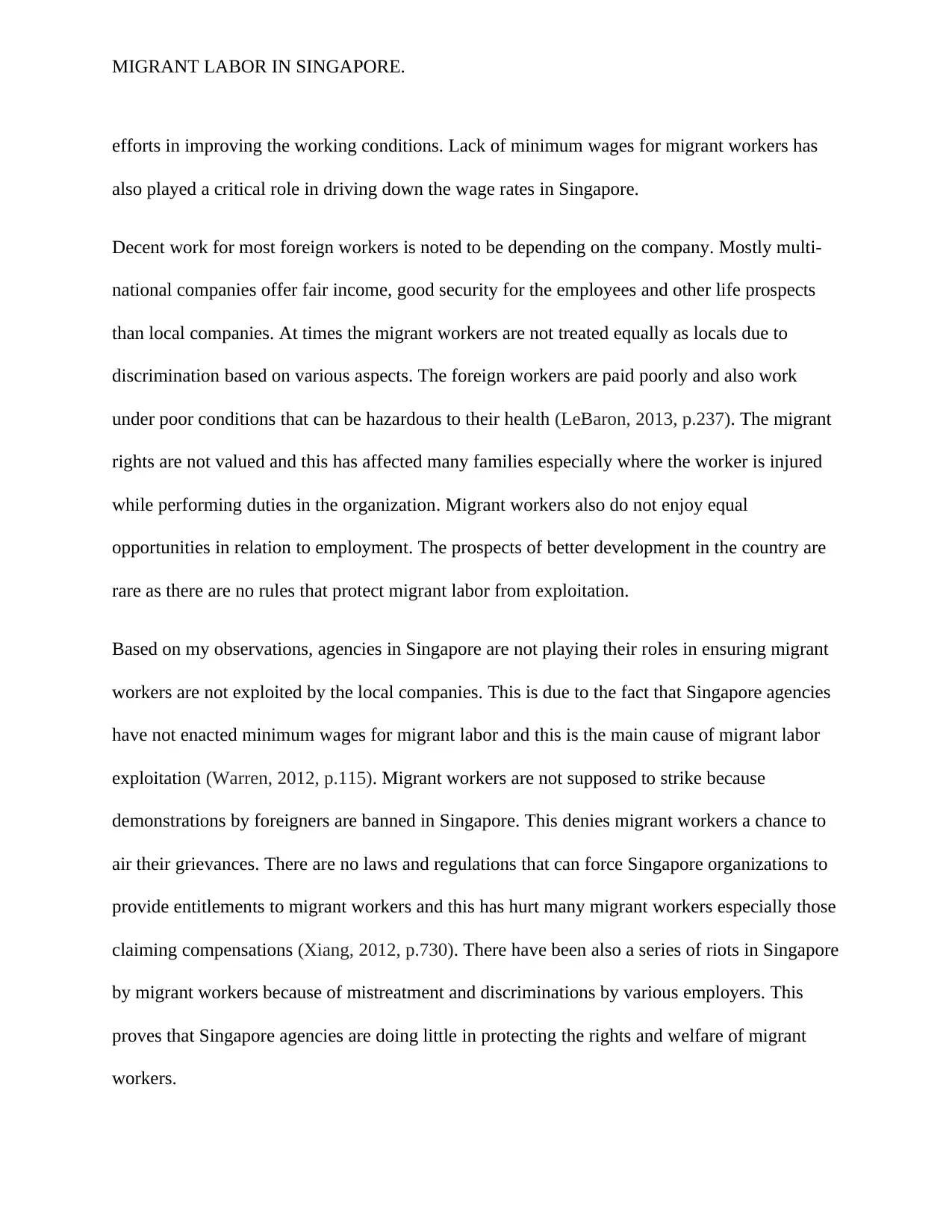
MIGRANT LABOR IN SINGAPORE.
efforts in improving the working conditions. Lack of minimum wages for migrant workers has
also played a critical role in driving down the wage rates in Singapore.
Decent work for most foreign workers is noted to be depending on the company. Mostly multi-
national companies offer fair income, good security for the employees and other life prospects
than local companies. At times the migrant workers are not treated equally as locals due to
discrimination based on various aspects. The foreign workers are paid poorly and also work
under poor conditions that can be hazardous to their health (LeBaron, 2013, p.237). The migrant
rights are not valued and this has affected many families especially where the worker is injured
while performing duties in the organization. Migrant workers also do not enjoy equal
opportunities in relation to employment. The prospects of better development in the country are
rare as there are no rules that protect migrant labor from exploitation.
Based on my observations, agencies in Singapore are not playing their roles in ensuring migrant
workers are not exploited by the local companies. This is due to the fact that Singapore agencies
have not enacted minimum wages for migrant labor and this is the main cause of migrant labor
exploitation (Warren, 2012, p.115). Migrant workers are not supposed to strike because
demonstrations by foreigners are banned in Singapore. This denies migrant workers a chance to
air their grievances. There are no laws and regulations that can force Singapore organizations to
provide entitlements to migrant workers and this has hurt many migrant workers especially those
claiming compensations (Xiang, 2012, p.730). There have been also a series of riots in Singapore
by migrant workers because of mistreatment and discriminations by various employers. This
proves that Singapore agencies are doing little in protecting the rights and welfare of migrant
workers.
efforts in improving the working conditions. Lack of minimum wages for migrant workers has
also played a critical role in driving down the wage rates in Singapore.
Decent work for most foreign workers is noted to be depending on the company. Mostly multi-
national companies offer fair income, good security for the employees and other life prospects
than local companies. At times the migrant workers are not treated equally as locals due to
discrimination based on various aspects. The foreign workers are paid poorly and also work
under poor conditions that can be hazardous to their health (LeBaron, 2013, p.237). The migrant
rights are not valued and this has affected many families especially where the worker is injured
while performing duties in the organization. Migrant workers also do not enjoy equal
opportunities in relation to employment. The prospects of better development in the country are
rare as there are no rules that protect migrant labor from exploitation.
Based on my observations, agencies in Singapore are not playing their roles in ensuring migrant
workers are not exploited by the local companies. This is due to the fact that Singapore agencies
have not enacted minimum wages for migrant labor and this is the main cause of migrant labor
exploitation (Warren, 2012, p.115). Migrant workers are not supposed to strike because
demonstrations by foreigners are banned in Singapore. This denies migrant workers a chance to
air their grievances. There are no laws and regulations that can force Singapore organizations to
provide entitlements to migrant workers and this has hurt many migrant workers especially those
claiming compensations (Xiang, 2012, p.730). There have been also a series of riots in Singapore
by migrant workers because of mistreatment and discriminations by various employers. This
proves that Singapore agencies are doing little in protecting the rights and welfare of migrant
workers.
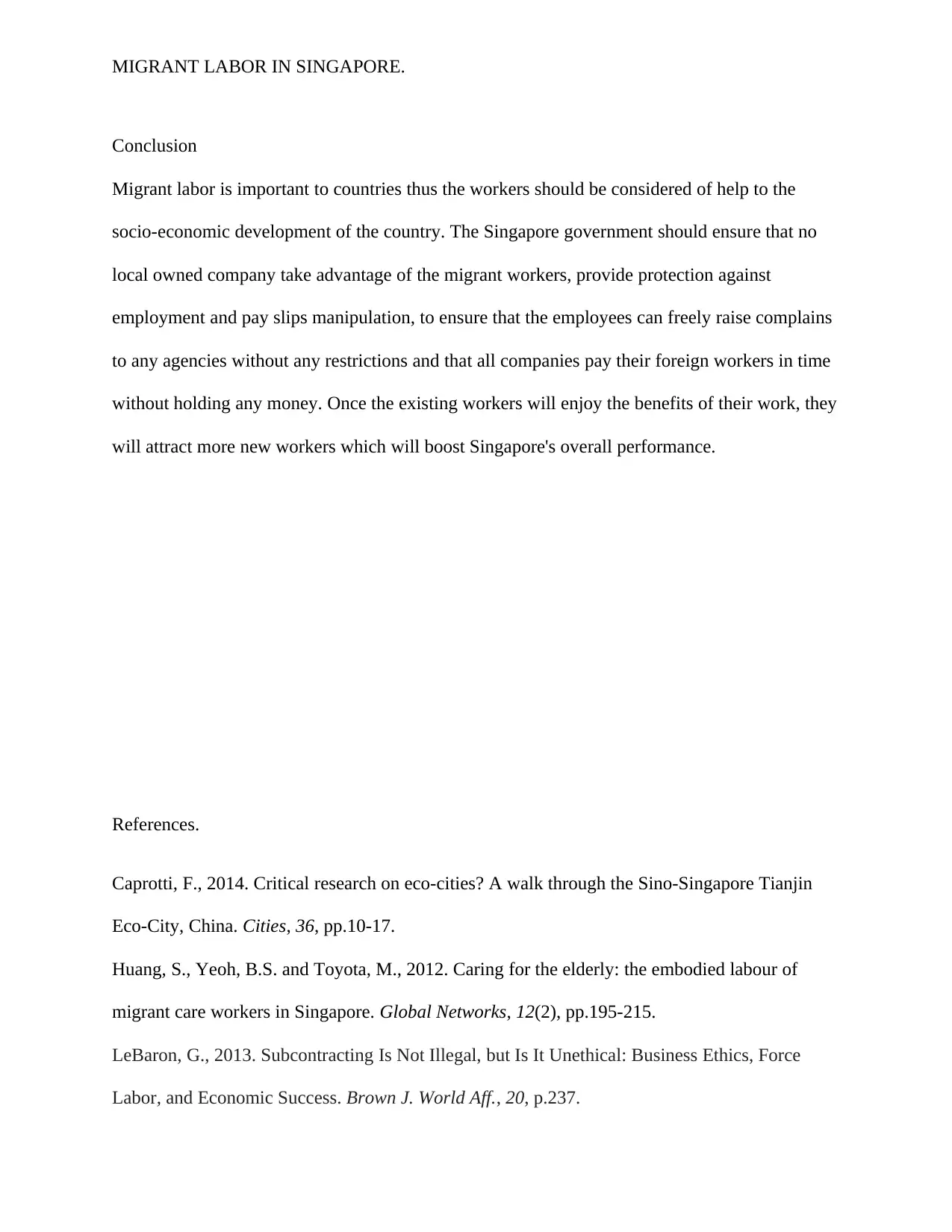
MIGRANT LABOR IN SINGAPORE.
Conclusion
Migrant labor is important to countries thus the workers should be considered of help to the
socio-economic development of the country. The Singapore government should ensure that no
local owned company take advantage of the migrant workers, provide protection against
employment and pay slips manipulation, to ensure that the employees can freely raise complains
to any agencies without any restrictions and that all companies pay their foreign workers in time
without holding any money. Once the existing workers will enjoy the benefits of their work, they
will attract more new workers which will boost Singapore's overall performance.
References.
Caprotti, F., 2014. Critical research on eco-cities? A walk through the Sino-Singapore Tianjin
Eco-City, China. Cities, 36, pp.10-17.
Huang, S., Yeoh, B.S. and Toyota, M., 2012. Caring for the elderly: the embodied labour of
migrant care workers in Singapore. Global Networks, 12(2), pp.195-215.
LeBaron, G., 2013. Subcontracting Is Not Illegal, but Is It Unethical: Business Ethics, Force
Labor, and Economic Success. Brown J. World Aff., 20, p.237.
Conclusion
Migrant labor is important to countries thus the workers should be considered of help to the
socio-economic development of the country. The Singapore government should ensure that no
local owned company take advantage of the migrant workers, provide protection against
employment and pay slips manipulation, to ensure that the employees can freely raise complains
to any agencies without any restrictions and that all companies pay their foreign workers in time
without holding any money. Once the existing workers will enjoy the benefits of their work, they
will attract more new workers which will boost Singapore's overall performance.
References.
Caprotti, F., 2014. Critical research on eco-cities? A walk through the Sino-Singapore Tianjin
Eco-City, China. Cities, 36, pp.10-17.
Huang, S., Yeoh, B.S. and Toyota, M., 2012. Caring for the elderly: the embodied labour of
migrant care workers in Singapore. Global Networks, 12(2), pp.195-215.
LeBaron, G., 2013. Subcontracting Is Not Illegal, but Is It Unethical: Business Ethics, Force
Labor, and Economic Success. Brown J. World Aff., 20, p.237.
⊘ This is a preview!⊘
Do you want full access?
Subscribe today to unlock all pages.

Trusted by 1+ million students worldwide
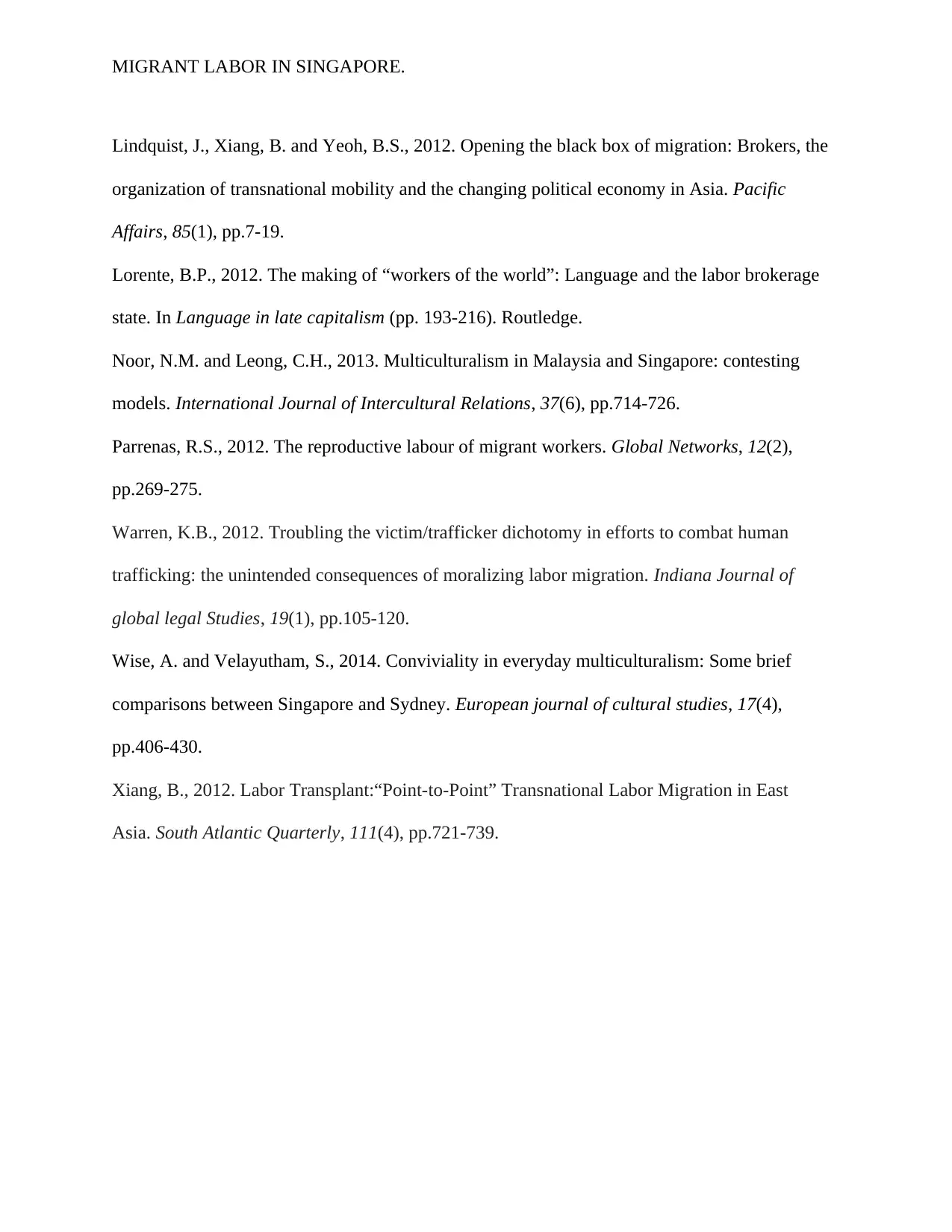
MIGRANT LABOR IN SINGAPORE.
Lindquist, J., Xiang, B. and Yeoh, B.S., 2012. Opening the black box of migration: Brokers, the
organization of transnational mobility and the changing political economy in Asia. Pacific
Affairs, 85(1), pp.7-19.
Lorente, B.P., 2012. The making of “workers of the world”: Language and the labor brokerage
state. In Language in late capitalism (pp. 193-216). Routledge.
Noor, N.M. and Leong, C.H., 2013. Multiculturalism in Malaysia and Singapore: contesting
models. International Journal of Intercultural Relations, 37(6), pp.714-726.
Parrenas, R.S., 2012. The reproductive labour of migrant workers. Global Networks, 12(2),
pp.269-275.
Warren, K.B., 2012. Troubling the victim/trafficker dichotomy in efforts to combat human
trafficking: the unintended consequences of moralizing labor migration. Indiana Journal of
global legal Studies, 19(1), pp.105-120.
Wise, A. and Velayutham, S., 2014. Conviviality in everyday multiculturalism: Some brief
comparisons between Singapore and Sydney. European journal of cultural studies, 17(4),
pp.406-430.
Xiang, B., 2012. Labor Transplant:“Point-to-Point” Transnational Labor Migration in East
Asia. South Atlantic Quarterly, 111(4), pp.721-739.
Lindquist, J., Xiang, B. and Yeoh, B.S., 2012. Opening the black box of migration: Brokers, the
organization of transnational mobility and the changing political economy in Asia. Pacific
Affairs, 85(1), pp.7-19.
Lorente, B.P., 2012. The making of “workers of the world”: Language and the labor brokerage
state. In Language in late capitalism (pp. 193-216). Routledge.
Noor, N.M. and Leong, C.H., 2013. Multiculturalism in Malaysia and Singapore: contesting
models. International Journal of Intercultural Relations, 37(6), pp.714-726.
Parrenas, R.S., 2012. The reproductive labour of migrant workers. Global Networks, 12(2),
pp.269-275.
Warren, K.B., 2012. Troubling the victim/trafficker dichotomy in efforts to combat human
trafficking: the unintended consequences of moralizing labor migration. Indiana Journal of
global legal Studies, 19(1), pp.105-120.
Wise, A. and Velayutham, S., 2014. Conviviality in everyday multiculturalism: Some brief
comparisons between Singapore and Sydney. European journal of cultural studies, 17(4),
pp.406-430.
Xiang, B., 2012. Labor Transplant:“Point-to-Point” Transnational Labor Migration in East
Asia. South Atlantic Quarterly, 111(4), pp.721-739.
Paraphrase This Document
Need a fresh take? Get an instant paraphrase of this document with our AI Paraphraser

MIGRANT LABOR IN SINGAPORE.
1 out of 8
Related Documents
Your All-in-One AI-Powered Toolkit for Academic Success.
+13062052269
info@desklib.com
Available 24*7 on WhatsApp / Email
![[object Object]](/_next/static/media/star-bottom.7253800d.svg)
Unlock your academic potential
Copyright © 2020–2025 A2Z Services. All Rights Reserved. Developed and managed by ZUCOL.





